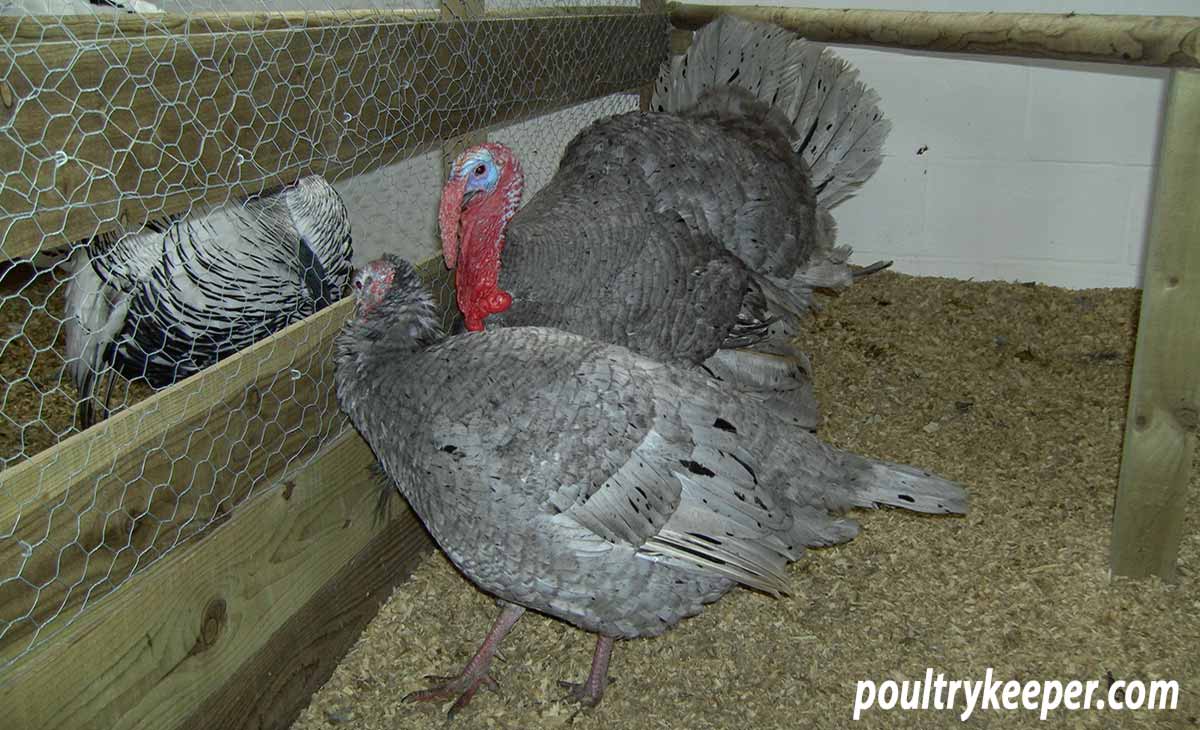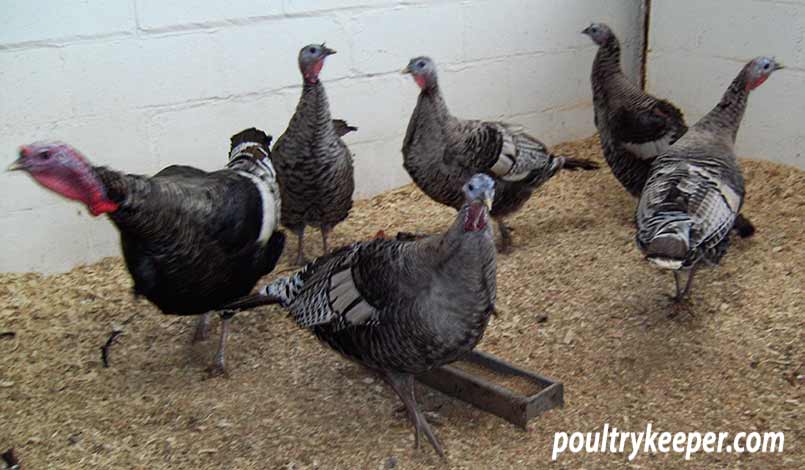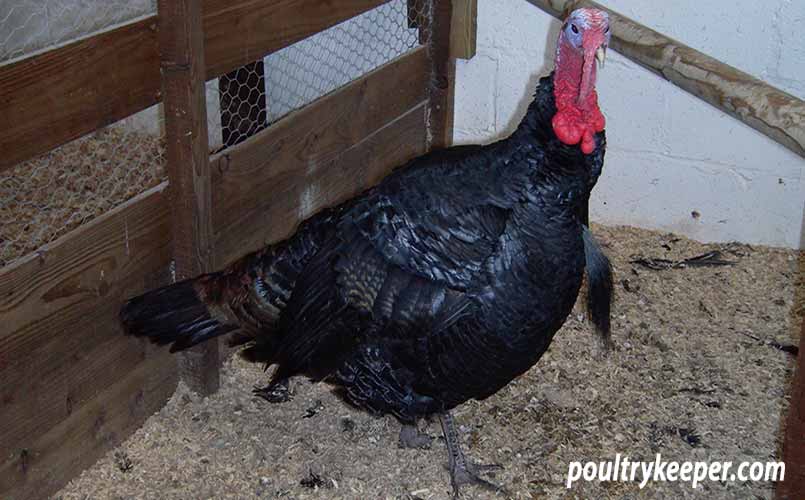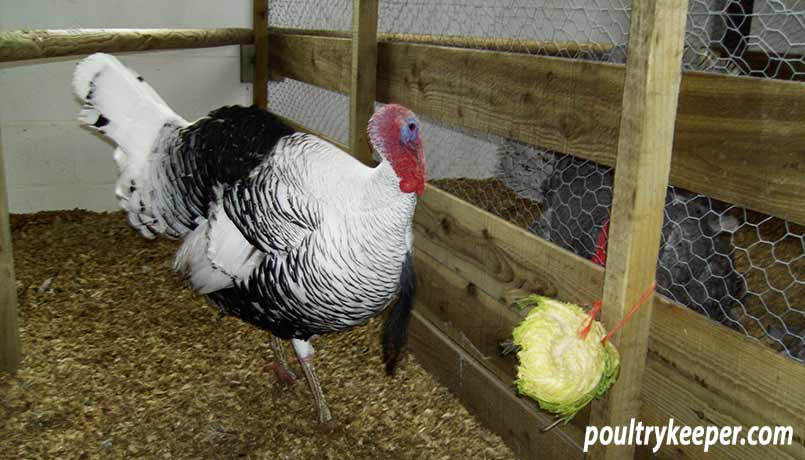
In this beginners guide to keeping turkeys, Janice Houghton-Wallace, the author of “Not Just for Christmas”, offers some tips and advice for newcomers to the fascinating world of keeping heritage turkeys at home.
Turkeys are large creatures, very impressive looking and fascinating to have around. This beginners guide to keeping turkeys will help you to get started keeping them at home in your garden or on a smallholding. Before thinking of buying some, though, you need to be sure you are allowed to keep them.
First considerations
If you live in a modern house, there may be a condition in the contract that does not allow livestock to be kept. Even a pet turkey is looked upon as livestock by the local authorities.
Consideration should also be given to your neighbours. Stag turkeys (males) gobble in reaction to any sound and hen turkeys have a wide vocabulary. Therefore it would be courteous to consult them and win them over before actually purchasing any birds.
Any poultry needs to be looked after 365 days a year and you may find it harder to enlist help to look after the turkeys if you plan to be away several times a year. Whatever you do never leave it to the last minute to arrange turkey care in case it is difficult to find. The birds cannot be left to their own devices and under The Animal Welfare Act it is your responsibility to care for their welfare.
There are a handful of rules about keeping chickens and other poultry you should be aware of before you get started.
Why keep turkeys?
With all this accepted, it depends on why you want to keep turkeys as to the area of land needed for them and their housing size.
If you intend to raise turkeys for the Christmas market, then working out how they will be dispatched come slaughtering time should be resolved before you even buy any. It is against the law [in the UK] for anyone to kill a turkey unless they have been trained to do so by attending a course or being shown by a suitably experienced person.

Housing turkeys
Half a dozen turkeys may be housed in an adapted good quality 8ft x 6ft garden shed. This is not large enough for them to be kept inside all the time but is ideal for overnight. It needs a ventilation area to be made near the roof, covered with small mesh wire. A 3inch round pole placed about 2½ft off the ground across the inside will make an acceptable perch.
Turkeys are not fox proof, so they must be safely housed at night. You need to be one step ahead of them when it comes to putting to bedtime because if you have left it too late, they will have flown up and perched on the roof or high up on some other building.
It is not advisable to leave them there because of severe weather in the winter and light mornings in the summer when Mr Fox will be still ranging around.
The above housing also applies to pet turkeys or turkeys kept for show, although if you have access to a large shed, it is a good idea to house the birds during the winter. Turkeys need to be kept clean, and dust-free shavings make a good litter. The cleaner they are kept, the healthier they are likely to stay. Stale faeces allow bacteria to build up, and turkeys will then succumb to respiratory and fungal diseases.
Fencing for keeping turkeys
Depending on your premises, you may have to fence an area for the birds. We can use 6ft high wire, but it is still possible for hen turkeys to fly over and out if they so wish. Generally, they are well behaved if there is sufficient room and vegetation to keep their interest.
Since this is a beginners guide to keeping turkeys, it doesn’t cover fencing in great detail, however, there is more information here on poultry fencing to keep predators out.
Worming turkeys
The main worry for turkey keepers is the disease Blackhead. This is caused by a protozoan worm that chickens can carry, but turkeys, pheasants and peafowl suffer from. If the land has had poultry on before or if the turkeys are to be near or with other forms of poultry, then everything needs to be checked for worms regularly by using a worm egg count and wormed if necessary. Kits are available online.
Worming turkeys about every six weeks when required, interferes with the life cycle of the Heterakis worm, which, if allowed to get through the gut, causes severe damage to the liver and is usually fatal.
The wormer licensed for use in poultry in the UK is Flubenvet, and a pack was recently brought out, especially for the smaller poultry keeper. Each pack is sufficient to treat up to 20 birds at a time and is available from veterinary practices, licensed agricultural merchants or online veterinary pharmacies.

Breeding
The mating season for turkeys begins in late January onwards, and hen turkeys running with stags should wear a breeding saddle. These are made from canvas or leather, and outlets are available via Turkey Club UK.
The saddle is put on the hen at the beginning of the mating season and remains on until August/September. They do not restrict the bird but prevent a great deal of possible damage from the stag. About four weeks after mating has begun, the females start to lay.
Turkey eggs are wonderful to bake with, but if you want to hatch them, they take 28 days to incubate. You can do this either in an incubator or under a broody hen or broody turkey. Turkeys make good mothers, but they must be put in a quiet, safe, isolated area and must not be disturbed by other birds around.
Natural incubation
During natural incubation, the hen turkey needs to be taken off the nest once a day for a wheat feed, drink and to empty herself. You will need to watch over her, or she will dash back to the nest, not having completed any of these tasks.
Artificial incubation
If artificially incubating eggs, once hatched and dry, the poults need to be moved to a secure and draught-free brooding area with a heat lamp. Young turkeys will need heat for around six weeks, depending on the time of the year and weather conditions.
Feeding turkeys
Feeding turkeys correctly is vitally important; they grow into big-boned birds and need a higher protein ratio than chickens.
Turkey starter crumbs contain 26-27% protein, which is higher than chick crumbs.
Chick crumbs should NOT be given, for not only have they insufficient protein, but some contain coccidiostats that are harmful to poults. A little chopped up hard-boiled egg mixed in with the crumbs will soon get turkey poults eating. Dip a poult’s beak into the drinking water to show it where to drink and how.
At around 4-5 weeks, the poults can be moved onto either turkey rearer pellets or turkey grower pellets. The rearer pellets are slightly lower in protein than the starter crumbs, and the grower pellets contain 21% protein which is slightly less than the rearer. From 9 weeks to adulthood, the poults remain on turkey grower pellets.
Turkeys destined for the table are put on turkey finisher pellets between 12-16 weeks. Still, if they are being kept for exhibition, conservation, breeding or as pets, then a turkey breeder pellet is given.
Wheat is not given until the birds are 12 weeks old, and then a little wheat is fed in the afternoon. Poultry grit is vitally important, and a little is given every week either separately or with the feed from young poults onwards. Chick grit then mixed poultry grit is given but never oyster shell alone as this can become compacted in the crop.

Treats for turkeys include apples, plums, sweet corn, sunflower seeds and cabbages. They will love to graze on grass and will chase insects and eat berries, so beware that there are no poisonous plants or berries in the area where they will be living.
There is further information in this article on feeding turkeys on this website.
Turkey varieties
It is a good idea to think about the variety of turkey you want before just buying any turkey. There are ten standard turkey varieties; these are the old turkeys that nature made with a high breastbone and not the commercial double-breasted birds you find in the supermarket that man developed.
Turkeys can be bought from many sources now but buying hatching eggs via the internet poses a risk as you cannot be sure that the eggs will be fertile or the birds pure. Buying an adult trio from a reputable breeder is possibly the best way to go about it.
Should you be tempted to buy from a livestock auction, do your homework first and get advice on the standard for the variety being sold and find out what they should actually look like.
Hopefully this beginners guide to keeping turkeys has helped you with the basics. You can learn more about turkeys in the Keeping Turkeys section of this website and Turkey Club UK; if you are interested in turkeys, do join the Club and receive help and information on all aspects of turkey care and the fun aspect of showing turkeys.
Photos and text Copyright Janice Houghton-Wallace.
